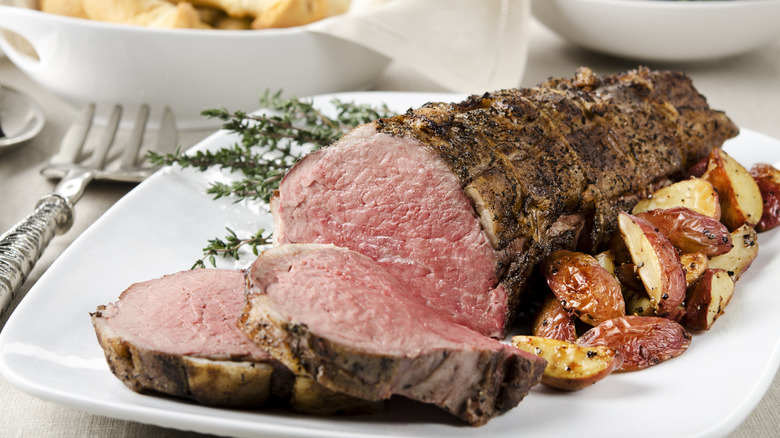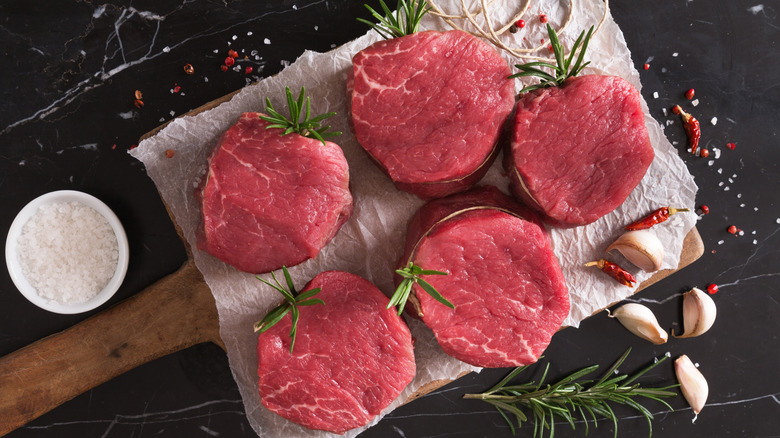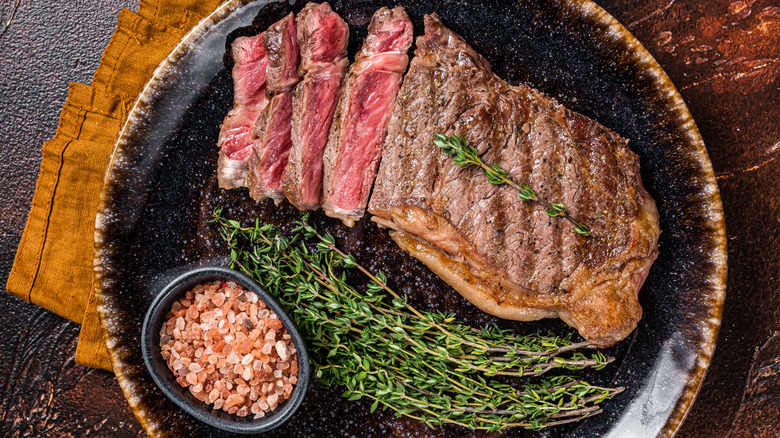Why You Shouldn't Choose The Tenderloin At A Steakhouse
With its mouth-watering aroma and rich, savory flavor, few dishes represent opulence quite like the mighty steak. This opulence is oftentimes not only reflected in steak's decadent taste and texture but also in its high prices. For many people, eating at a steakhouse is a luxury reserved only for special occasions. When the opportunity to indulge in a steak does come around, it's reasonable to try and pick the best cut on the menu. A lot of chefs and foodies like to point to tenderloins as one of the best options to pick off a steakhouse menu due to its melt-in-your-mouth texture. But while there's no doubt tenderloins are certainly tender, they don't offer the most bang for your buck.
A beef tenderloin is a long, thin cut of meat located under the sirloin. One end of the tenderloin is typically used for roasts, while the other end is often used to make filet mignon. Both filet mignon and tenderloin as a whole are desired for having a buttery, rich texture without a lot of fat, but this lack of fat also means that this cut of meat tends to have an underwhelming flavor. There are a lot of techniques steakhouses use to trick your tastebuds, so while the tenderloin may be tempting, you're better off skipping it during your next dinner out.
Tenderloins lack flavor
In the meat world, fat is necessary for full-flavored, juicy steaks. Specifically, fat that appears as marbling in the meat — swirls or flecks of white fat within the red muscle — is a sure indicator that you're in for an incredible meal. As the steak cooks, the meat absorbs the fat, creating a tasty, tender final result. Tenderloin and filet mignon don't have any marbling, which means any fat used in the cooking process comes from butter or oil. This dilutes the steak's meaty flavor and doesn't deliver the oomph you want from a restaurant steak.
As chef and restaurant owner Laurent Tourondel told Thrillist, filet mignon is "a good cut for those who aren't big on meat because it doesn't have much natural fat," but "the flavor is just less robust and beefy than other cuts." Despite this, tenderloin cuts are still rather pricey, at almost $36 for 9 ounces at some steakhouses. For that price or less, you can splurge on a much more worthwhile offering.
What to order instead
Along with tenderloins, ribeyes and New York strip steaks are common recommendations. Via Real Simple, COO of Flannery Beef Katie Flannery explains that ribeye sits on the opposite end of the spectrum from filet mignons: Not as tender, but ultra tasty. New York strip steaks, meanwhile, are a happy medium between the two other cuts. Even though these alternative steaks provide more of a substantial, meaty dining experience, they typically cost less than filet or tenderloin cuts. Depending on where you're eating, ordering a New York strip or ribeye at a steakhouse will get you more for your money in both quality and quantity.
Over on Reddit, commenters also recommend New York strip steaks, along with flank steaks and sirloins. Another popular alternative to tenderloin is hanger steak. This cut is like a more tender version of skirt steak and is one of the best steaks for beginner grillers. After all, making a good steak is all about preparation, so it's easy to turn a hanger steak into a restaurant-worthy meal. These days, steaks served at the most exclusive restaurants can have price tags over $100, and even more casual chains charge a minimum of $20 for a sirloin. If you plan on celebrating with a steak anytime soon, make sure to get your money's worth and decline the tenderloin.


